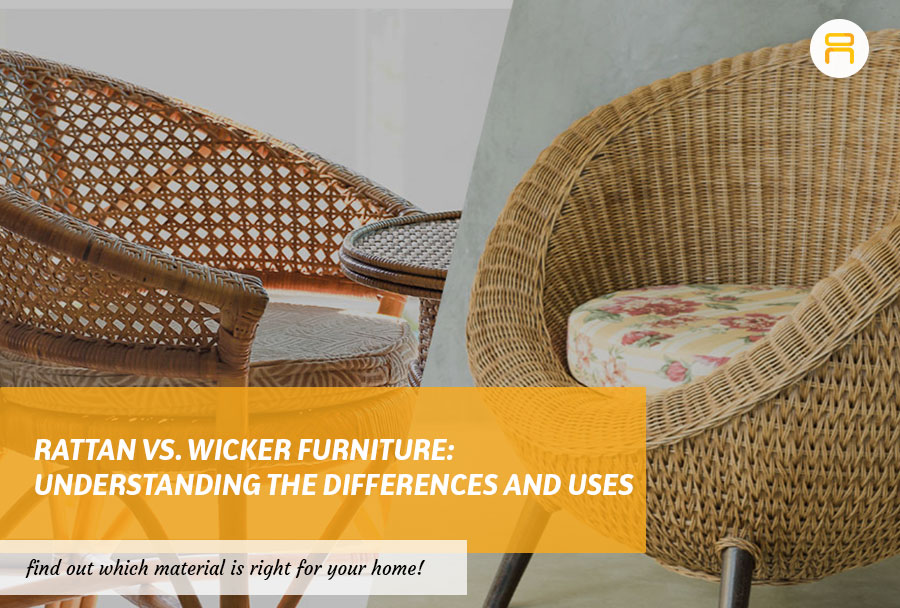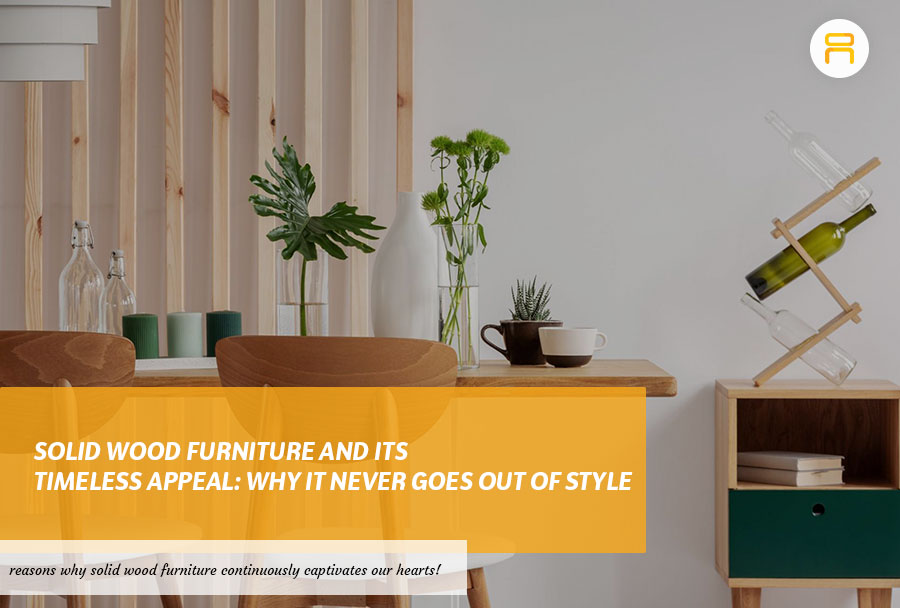
Rattan vs. Wicker Furniture: Understanding the Differences and Uses
You might have come across the terms “rattan” and “wicker” when you were shopping for furniture or maybe looking into local handicrafts–-thinking they’re somewhat alike since these terms have frequently been used interchangeably. But did you know that they actually refer to different things?
In this article, we’ll break down the differences between rattan and wicker furniture, their benefits, and the best ways to use them in your home. By the end, we hope that you’ll have a clear understanding of these popular furniture styles and how to incorporate them into your living spaces.
What’s Inside
- What is Rattan?
- What is Wicker?
- What are the Differences Between Rattan and Wicker Furniture?
- How to Choose Between Rattan and Wicker Furniture
- How to Incorporate Rattan and Wicker Furniture in Your Home
- FAQs About Rattan and Wicker
What is Rattan?
Rattan is a natural material derived from the stems of tropical palm plants found in Asia, Australia and Africa. It’s known for its sustainability, strength and durability, making it a popular choice for furniture making.
Related: Top 7 Sustainable Furniture Materials For Your Home
Characteristics of Rattan
- Durability
Rattan is one of the toughest natural materials used in furniture making. It has a high tensile strength, meaning it can handle significant stress without breaking. This makes it ideal for outdoor or patio furniture use and occasional rough handling.
- Flexibility
One of rattan’s most remarkable features is its flexibility. The core of the rattan vine is pliable, allowing it to be easily bent and shaped. This flexibility enables craftsmen to weave it into intricate designs and curves in furniture and other crafts that would be challenging with more rigid materials.
- Natural Aesthetic
Rattan has a unique texture and appearance. Its natural, earthy look adds a warm, organic touch to spaces. The material’s grain and color variations contribute to its charm, that’s why each piece of rattan furniture is somewhat unique.
Types of Rattan Materials Used in Furniture
Here are some of the types of rattan materials commonly used in furniture:
- Synthetic Rattan
Typically made from plastic materials such as PVC, PU, and PE, synthetic rattan mimics the look of natural rattan while being highly durable and weather-resistant. It’s perfect for outdoor furniture as it withstands UV rays, rain, and temperature changes, and is easy to clean and maintain.
- Manau Rattan
Manau is a type of rattan native to Southeast Asia known for its strength and flexibility. It’s thicker and more robust, making it ideal for crafting sturdy and elegant furniture pieces that last.
- Cane Rattan
Cane rattan is the layer beneath the thorny outer skin of the rattan vine. It’s known for its flexibility and is often used for detailed weaving in furniture. This makes it perfect for creating intricate designs and decorative features, combining both beauty and durability.
Type of Rattan Weave
- Full Round Weave
Compared to half round weave, full round is thicker and more durable. Because of its thickness, it’s more difficult to weave that’s why it tends to have a higher cost and is typically used in expensive outdoor furniture.
- Half Round Weave
The half round weave uses rattan strands that are curved on one side, creating a smooth and modern texture. It’s thicker and stronger than flat weaves, and is usually used in making the armrest or backrest of an outdoor furniture.
- Flat Weave
The flat weave is the most commonly used type of rattan weave for outdoor and budget-friendly furniture. It’s characterized by thin strips of synthetic rattan, showcasing a modern and smooth finish. This weaving material is also lightweight, easy to move around, and waterproof, but might be more prone to damage compared to full round and half round.
Benefits of Rattan Furniture
- Eco-Friendly
Rattan is a sustainable resource because it grows quickly and regenerates easily. Harvesting rattan doesn’t require cutting down trees, making it a more environmentally friendly option compared to hardwoods.
- Lightweight
Despite its strength, rattan furniture is relatively lightweight. This makes it easier to move around, rearrange, or transport, which is especially handy for those who frequently update their home decor.
- Versatile
Rattan furniture can be finished in various ways, including staining, painting, or weaving with other materials. This versatility allows it to fit seamlessly into both traditional and contemporary home decor styles.
What is Wicker?
Wicker refers to the weaving process used to create furniture, not the material itself. Wicker furniture can be made from various materials, including rattan, bamboo, reed, and synthetic fibers.
Characteristics of Wicker
- Weaving Technique
Wicker furniture is created using a weaving technique where various fibers are interlaced to form sturdy and stylish pieces. This technique allows for intricate patterns and designs, resulting in furniture that is both functional and visually appealing. - Versatility
Wicker is highly versatile and can be made into many different designs. Whether you want a classic, detailed look or a modern, minimalist style, wicker can be woven to match various decor themes. This flexibility makes it a popular choice for both indoor and outdoor spaces. - Lightweight and Durable
Wicker furniture shares similar characteristics with rattan in being lightweight yet durable. This makes it easy to move and rearrange while still being strong enough to handle regular use. It’s suitable for both indoor and outdoor spaces, providing comfort and longevity in various environments..
Types of Wicker Furniture
- Natural Wicker
This type of wicker furniture is crafted from natural materials such as rattan, bamboo, willow, and reed. These materials give the furniture a classic, timeless look that brings a touch of nature and warmth into your home.
Natural wicker’s unique texture and patterns add a handcrafted charm, making it a popular choice for traditional and rustic decor styles for your indoor space. However, it may not be the best choice for patio furniture as it can be sensitive to moisture, rain, and other extreme weather conditions.
- Synthetic Wicker
Synthetic wicker furniture is made from man-made fibers like resin or plastic. It’s designed to look like natural wicker but offers superior durability and resistance to weather conditions. Synthetic wicker is more resilient to moisture, UV rays, and temperature changes, making it ideal for outdoor use. It combines the stylish appearance of natural wicker with enhanced longevity and easier maintenance.
Benefits of Wicker Furniture
- Aesthetic Appeal
Wicker furniture features beautiful weaving patterns that bring elegance and charm to any room. The intricate designs and textures add a unique touch, making wicker pieces stand out as stylish focal points in your decor.
- Weather-Resistant Options
Synthetic wicker is specially designed to handle various weather conditions. It’s treated to resist moisture, UV rays, and temperature changes, making it perfect for outdoor settings like patios and gardens. This means it won’t easily fade, crack, or get damaged by rain or sun.
- Low Maintenance
Wicker furniture is easy to care for, particularly when made from synthetic materials. It typically requires just a quick wipe-down or rinse to keep it clean. Unlike natural wicker, which may need more frequent maintenance to prevent mold and wear, synthetic wicker is designed for hassle-free upkeep.
What are the Differences Between Rattan and Wicker Furniture?
Material and Technique
Rattan is a natural material known for its long, flexible stems. It can be used whole or split into strips for furniture making. While wicker is a weaving technique that uses various materials, including rattan, bamboo, reed, and synthetic fibers. This method allows for a wide range of furniture styles and designs.
Durability and Maintenance
Rattan is a strong and durable material, perfect for furniture used regularly. To maintain its condition, keep rattan furniture dry, clean it regularly, and occasionally apply a protective finish. Wicker furniture’s durability varies with the materials used: natural wicker, such as rattan, bamboo, or reed, is sturdy but can be damaged by moisture and sun. Synthetic wicker, made from resin or plastic, withstands UV rays and rain, making it ideal for outdoor use and requiring less maintenance.
Aesthetic and Style
With its distinct texture and warm, earthy tones, rattan adds a cozy, rustic charm to any space. In contrast, wicker furniture is highly versatile and comes in a variety of styles and patterns, making it easy to match with different decor themes, from traditional to modern.
How to Choose Between Rattan and Wicker Furniture
Consider Your Space
- Indoor Use: Both rattan and wicker furniture can be used indoors. Consider rattan for a more natural look and wicker for more design options.
- Outdoor Use: Both synthetic rattan and wicker are generally suitable for outdoor use due to their weather-resistant properties.
Think About Maintenance
- Rattan Furniture: Requires regular dusting and occasional cleaning to maintain its appearance. Nonetheless, it’s relatively easy to clean as long as it’s done regularly.
- Wicker Furniture: Synthetic wicker is low maintenance, while natural wicker may need more care to prevent damage from moisture and sunlight.
Match Your Decor Style
- Rattan Furniture: Best for rustic, bohemian, or coastal decor styles.
- Wicker Furniture: Versatile enough to complement modern, traditional, or eclectic decor.
How to Incorporate Rattan and Wicker Furniture in Your Home
Living Room
- Rattan Chairs: Add a rattan armchair or loveseat to create a cozy reading nook. The natural texture and warm tones of rattan make it a perfect spot for relaxing with a book.
- Wicker Coffee Table: A wicker coffee table makes a stylish centerpiece in your living room. Its detailed weaving adds visual interest and elegance to the space.
Bedroom
- Rattan Headboard: A rattan headboard brings natural elegance to your bedroom. Its unique texture adds a sophisticated touch and makes your bed a standout feature.
- Wicker Storage Baskets: Use wicker baskets for storage and to add texture to your room. They help keep things organized while enhancing the room’s style.
Outdoor Spaces
- Rattan Dining Set: A rattan dining set is great for outdoor meals and gatherings. It combines style and durability, making it ideal for enjoying meals in the open air.
- Wicker Lounge Chairs: Wicker lounge chairs offer comfort and style for relaxing on the patio. They’re durable and easy to maintain, perfect for outdoor relaxation.
FAQs About Rattan and Wicker
1. Is rattan furniture durable?
Yes, rattan furniture is naturally strong and durable. However, just like any other furniture, it requires regular maintenance to keep it in good condition, such as keeping it dry and occasionally applying a protective finish to prevent wear and tear.
2. Is rattan furniture weatherproof?
Rattan furniture itself is not weatherproof. Natural rattan can be affected by moisture and sun exposure, which can lead to damage if not properly maintained. For outdoor use, synthetic rattan furniture is a better choice as it is designed to be weather-resistant and can withstand various environmental conditions.
3. Can wicker furniture be used outdoors?
Wicker furniture’s suitability for outdoor use depends on the materials. Synthetic wicker, made from resin or plastic, is designed to handle weather conditions and is ideal for outdoor settings. Natural wicker, made from materials like rattan, bamboo, or reed, may not be as weather-resistant and is better suited for indoor use or covered outdoor areas.
4. How do I maintain rattan furniture?
To maintain rattan furniture, keep it clean and dry. Regularly dust and wipe it down to prevent mold and mildew. For added protection, re-coat it occasionally with a suitable finish to preserve its natural look and extend its lifespan.
5. What styles can wicker furniture come in?
Wicker furniture is available in a wide range of styles and patterns. It can be crafted into traditional, intricate designs or sleek, modern patterns. This versatility allows wicker to fit various decor themes, from classic to contemporary.
6. Which is more expensive: rattan or wicker?
The cost can vary depending on the material and craftsmanship. Generally, rattan furniture can be more expensive because it is made from a natural, high-quality material and involves detailed work. Wicker furniture can be less expensive, especially if it uses synthetic materials or simpler designs.
If you are looking for home furniture in the Philippines, visit our page. We have a variety of furniture items for you to choose from!
Like our Facebook page and follow us on our Instagram to keep in touch with us regularly.



